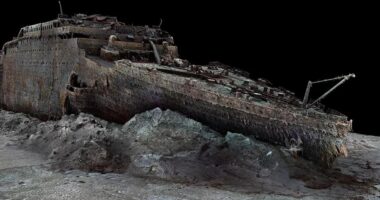NASA’S latest Mars rover has captured rare footage of a “dust devil” skittering across the planet’s surface.
The extra-terrestrial twister was picked up by one of Perseverance’s 19 onboard cameras in video shared by Nasa on social media this week.
“You can see it in the distance behind my robotic arm in this enhanced view,” the official Perseverance Twitter account wrote on March 16.
“The dust devil is moving right to left and creating whirlwinds of dust in its path.”
Perseverance touched down in the Jezero crater on February 18 on a two-year mission to hunt for signs of past life.
Nasa spent weeks painstakingly testing the $2billion machine’s instruments but it is now on the move and capturing footage of its surroundings.
Nasa did not say how big the dust devil was, or how fast it’s thought to have been travelling.
The largest can reach 330ft (100m) wide and five miles (8km) tall – far bigger than those found on Earth.
It’s rare to capture footage of one from a rover as they travel at high speeds and are tricky to predict. Nasa’s Curiosity rover nabbed images of a 160ft (50m) dust devil last summer.
Nasa has previously explained how the vortexes of spinning air appear on the Red Planet.
“Dust devils form by rising and rotating warm air pockets,” the space agency said.
“When the incoming air rises into the column, its rotation picks up speed like a spinning ice skater bringing their arms closer to their body.
“This faster moving air near the soil surface can cause sand grains to bounce and kick up dust which easily rises up into the growing vortex. In this way a dust devil is born.”
The study of dust devils can help scientists figure out prevailing wind directions and speed on Mars.
They also periodically cleanse the surface of the dust that gradually settles from the atmosphere.
“This is something that can be extremely helpful to robotic missions to keep their solar panels from getting too dusty,” Nasa says.
Perseverance is Nasa’s most complex Mars rover yet, sporting seven scientific instruments.
Over the next two years, Perseverance will look for signs of alien life and carry out tests that are key to future manned missions to the planet.
The primary objective of Perseverance’s two-year mission is to dig up soil samples that could contain evidence of past life.
The samples will be collected by a separate spacecraft due to arrive at Mars in 2028.
They will be analysed by scientists when they arrive back at Earth in the 2030s.
Perseverance – What’s on board?

Perseverance boasts a total of 19 cameras and two microphones, and carries seven scientific instruments.
- Planetary Instrument for X-Ray Lithochemistry (PIXL)
An X-ray “ray gun” that will help scientists investigate the composition of Martian rock.
2. Radar Imager for Mars’ subsurface experiment (RIMFAX)
A ground-penetrating radar that will image buried rocks, meteorites, and even possible underground water sources up to a depth of 10 metres (33ft).
3. Mars Environmental Dynamics Analyzer (MEDA)
A bunch of sensors that will take readings of temperature, wind speed and direction, pressure, and other atmospheric conditions.
4. Mars Oxygen ISRU Experiment (MOXIE)
An experiment that will convert Martian carbon dioxide into oxygen. A scaled-up version could be used in future to provide Martian colonists with breathable air.
5. SuperCam
A suite of instruments for measuring the makeup of rocks and regolith at a distance
6. Mastcam-Z
A camera system capable of taking “3D” images by combining two or more photos into one.
7. Scanning Habitable Environments with Raman and Luminescence for Organics and Chemicals (SHERLOC)
From Baker Street to Mars: Sherloc contains an ultraviolet laser that will investigate Martian rock for organic compounds.
In other news, water that once flowed over the surface of Mars is now trapped within its crust, a Nasa-funded study revealed this week.
Nasa has announced that it is accepting applications for wannabe space explorers who wish to fire their names to the Red Planet.
And, Perseverance revealed stunning video and audio recordings from the surface of the Red Planet last month.
What do you make of the rover clip? Let us know in the comments!
We pay for your stories! Do you have a story for The Sun Online Tech & Science team? Email us at [email protected]
This post first appeared on Thesun.co.uk




















